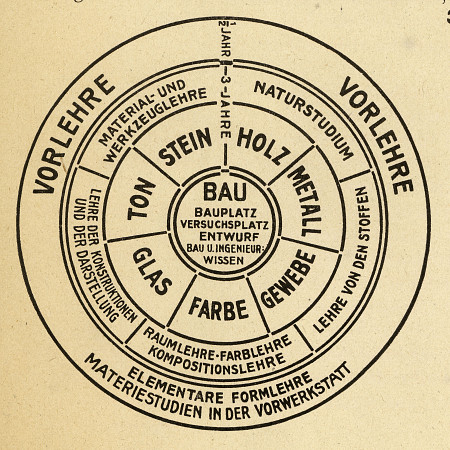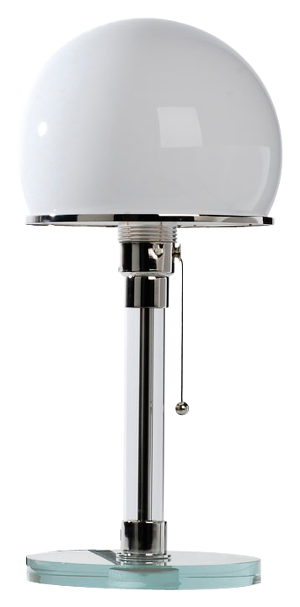
Teaching at the Bauhaus
This conceptual diagram showing the structure of teaching at the Bauhaus was developed by Walter Gropius in 1922. The programme places ‘building’ [Bau] at the centre of all the activities. But a regular course in architecture was only introduced at the Bauhaus in 1927. Only the most talented students were admitted to the architecture course. At the start of their studies, they received a year of basic training in the so-called preliminary course, in which they were able to experiment with colour, shape and materials with no specific goals. Depending on their individual suitability, this was followed by practical work in the workshops and accompanying disciplines. The students entered the workshops as ‘apprentices’ and were to sit their ‘apprenticeship’ exams within a given time period.
Educational courses with this type of structure were unprecedented and had to be completely newly developed by Gropius initially. The choice of teachers was all the more decisive for the development of the Bauhaus’s viewpoints. Gropius succeeded in gaining the support of renowned avant-garde artists for the purpose. In Weimar, they carried out the teaching as ‘form masters’, together with the ‘work masters’ – trained craftsmen.
To begin with, almost all of the workshops, like the preliminary course, were formatively influenced by Johannes Itten. Instead of getting the students to copy from models, as was still done in the traditional academies of art, he encouraged them to produce their own creative designs based on their own subjective perceptions. In the preliminary course, he taught the foundations of materials properties, composition, and colour theory. After Itten’s departure, the preliminary course was divided between László Moholy-Nagy and Josef Albers. Moholy-Nagy shifted the emphasis from artistic issues to technical ones and developed exercises on construction, balance and materials. Albers was responsible for familiarizing the students with craft techniques and appropriate use of the most important materials.
Beyond the preliminary course, Paul Klee and Wassily Kandinsky, among others, supervised and supplemented the teaching work on form and colour theory, and Oskar Schlemmer taught the analysis and depiction of the human body. In addition, classes were taught in non-artistic disciplines such as mathematics and building materials.
Almost all of the masters moved to Dessau along with the college. Former students took over the direction of the workshops, as young masters: Marcel Breuer headed the carpentry workshop, Herbert Bayer the printing and advertising workshop, Hinnerk Scheper the workshop for mural painting, Joost Schmidt the sculpture workshop and Gunta Stölzl the weaving workshop. In addition to the training, the declared goal was now ‘to carry out practical experimental work, particularly for house construction and interior decoration, as well as to develop model types for industry and crafts specialists’. Technical and formal experiments were carried out in the workshops on a broad basis in order to develop prototypes for industrial manufacturing and make it possible for broad strata of purchasers to buy qualitatively high-standard but affordable goods. The theoretical teaching was placed on a broader basis and engineering, psychology, business economics and other subjects were included in the teaching programme. The masters were now called professors, and the students received a Bauhaus diploma.
Under the third Director, Ludwig Mies van der Rohe, the Bauhaus ultimately developed into a kind of college of technology for architecture. Mies van der Rohe reduced the structure and importance of work in the workshops. The art and workshop department now mainly served as groundwork and orientation for developing a more up-to-date form of architecture that used contemporary structures and materials.
